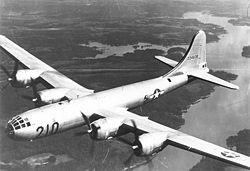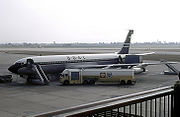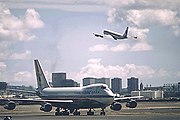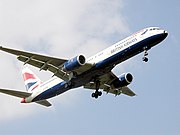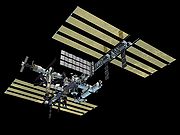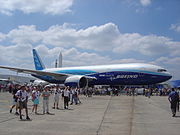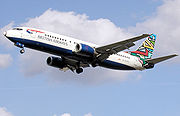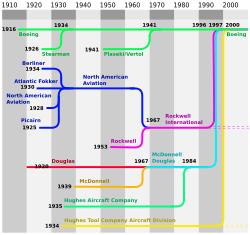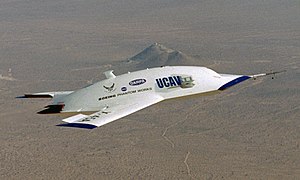Boeing és un dels principals fabricants d'avions i equips aeroespacials del món. El seu nom complert és The Boeing Company i la seva seu central es troba a la ciutat de Chicago, EUA. Les principals factories estan situades a les rodalies de la ciutat de Seattle, a l'estat de Washington, EUA, prop de la costa de l'oceà Pacífic.
[edita] Inicis
La companyia, originalment anomenada "B&W" fou fundada per William E. Boeing i George Conrad Westervelt el 1916. Al següent any, ja va anomenar-se "Boeing Airplane Company". William E. Boeing havia estudiat a la universitat de Yale i va treballar inicialment al sector de la fusta, on es va convertir en un home ric i on va adquirir coneixements sobre estructures de fusta que més tard resultarien d'utilitat en la construcció d'avions.
El 1934 Boeing ja era una companyia molt gran i William E. Boeing va optar per vendre totes les seves participacions a raó de la llei que s'havia promulgat als Estats Units després de la gran depressió que obligava a totes les empreses de certa dimensió a dividir-se en unitats més petites i independents.
Poc després, la companyia va establir un acord amb la Pan American World Airways per desenvolupar i construir un hidroavió civil capaç de transportar passatgers en rutes transoceàniques i dissenyat per utilitzar l'aigua com a pista d'aterratge. El juny del 1938 el nou avió, denominat Boeing 314 Clipper, va realitzar el primer vol. Fou l'avió més gran de la seva època amb capacitat per a 90 passatgers en vols de dia i 40 en vols nocturns. Un any més tard es va inaugurar el primer servei regular entre la costa est dels Estats Units i el Regne Unit. A partir de llavors es van establir altres rutes de llarg recorregut amb el Clipper fins al punt de que la Pan American va disposar de vols a destins de tot el món.
[edita] La Segona Guerra Mundial i la Guerra Freda
Durant la Segona Guerra Mundial, Boeing va construir una enorme quantitat de bombarders. Molts dels seus treballadors van ser dones que els seus marits havien anat a la guerra. A principis de març de 1944 la producció s'havia incrementat de tal forma que cada mes es fabricaven fins a 350 avions. Per prevenir un atac des de l'aire, els edificis de les fàbriques van ser coberts amb vegetació i elements del camp a mode de camuflatge. Durant els anys de la guerra, les principals companyies nord-americanes van col·laborar de forma molt estreta de tal manera que el bombarder B-17 de Boeing va ser fabricat també per Lockheed i per Douglas, mentre que el B-29 Superfortress fou muntat també per Bell i per Martin.
Finalitzada la guerra, es van cancel·lar totes les comandes de bombarders i 70.000 treballadors es van quedar sense feina. La companyia va fer tots els possibles per generar noves vendes, per lo que va fabricar el Stratocruiser, un avió de passatgers basat en un avió militar. No obstant, aquest model no va tenir l'èxit esperat i Boeing va tenir que buscar altres alternatives per superar la crisi. Ho va aconseguir en bona mesura amb la venta d'avions militars dissenyats pel transport de tropes i com a avions nodrissa que permetien a altres avions fer gasolina a l'aire.
A mitjans dels anys 50 la tecnologia va avançar significativament, el que va permetre a Boeing desenvolupar productes totalment nous i innovadors. Un dels primers fou un míssil teledirigit de curt abast, dissenyat per a respondre a atacs d'avions enemics. Durant aquests anys de la Guerra Freda era ja un fet i Boeing va utilitzar els seus coneixements en míssils de curt abast per desenvolupar un míssil intercontinental.
[edita] L'era Jet

Boeing va introduir el 1955 el primer avió comercial a reacció dels Estats Units. Prèviament ja havien aparegut dos avions d'aquest tipus a Europa: el Comet fabricat al Regne Unit i el Caravelle, fabricat a França. Amb el nou avió, el Boeing 707, Boeing es va convertir en líder dels fabricants d'avions de passatgers a reacció. Es tractava d'un avió quadrimotor amb capacitat per a 156 passatgers i destinat a rutes de llarg recorregut. Poc després Boeing va desenvolupar una segona versió d'aquest avió, el Boeing 720, per a rutes menys llargues i poc temps després va aparèixer el Boeing 727, un avió de capacitat similar però dotat de tres motors i concebut per rutes mitges i curtes. Aquest avió va tenir una immediata acollida, molt positiva per les companyies aèries, pels pilots i pels passatgers per la seva comoditat i fiabilitat. Encara que es va deixar de fabricar al 1984, a principis del segle XXI encara hi havia en servei uns 1.300 Boeing 727 per tot el món.
A l'any 1967 la companyia va introduir un nou model, el Boeing 737, que s'ha convertit en l'avió de passatgers més venut en tota la història de l'aviació civil. Es tracta d'un avió bimotor dissenyat per a rutes curtes i mitges, amb capacitat per uns 160-220 passatgers, segons la versió i la configuració de seients. El 737 segueix fabricant-se i és objecte de continuades millores addicionals, generalment versions més llargues per a una major capacitat de passatgers. Existeix fins i tot un 737 de negocis per a grans empreses per realitzar les funcions d'un gran jet privat, el Boeing Business Jet.
Al comença la dècada dels 70, Boeing va haver de afrontar una nova crisi. El programa espacial Apollo, en el que Boeing havia estat participant de forma important, va ser cancel·lat gairebé per complert. Una vegada més l'empresa va confiar en poder compensar la pèrdua de vendes amb els seus avions comercials. No obstant, en aquella època, les línies aèries de tot el món travessaven un mal moment i Boeing no va rebre ni una sola nova comana de tot un any. La seva aposta de futur, el Boeing 747, derivat d'un projecte de transport estratègic per a l'exèrcit dels Estats Units, s'estava endarrerint en la seva fabricació i originava costos més elevats del previst. A tot se li va sumar que el Congrés dels Estats Units va desestimar el recolzament financer al projecte d'avió supersònic de Boeing, la resposta a l'avió supersònic franco-anglès Concorde i es va veure amb la obligació d'abandonar un projecte en el que ja havia invertit una enorme quantitat de diners. Un cop més, Boeing va tindre de reduïr la seva plantilla que va passar de 80.000 treballadors a 40.000 tan sols a l'àrea de Seattle. Per fi, al 1970, el primer exemplar del nou avió, el Boeing 747, el famós Jumbo, es va posar en servei: un quadrimotor de llarg recorregut amb capacitat per a 460 passatgers i el més gran avió comercial de la història de l'aviació fins a la construcció de l'Airbus A380. Aquest avió va tenir un èxit extraordinari des de la seva aparició. En les diferents versions que s'han desenvolupat, segueix essent un avió sense competència. L'aparició de l'Airbus A380, un avió de dos pisos amb capacitat de passatge superior al 747, Boeing es troba amb el primer competidor de la història del Jumbo.
Durant el 1983 la situació econòmica va tornar a millorar, amb ell les companyies aèries. Boeing va lliurar l'exemplar número 1.000 del 737. A mesura que els trànsit de passatgers augmentava a tot el mon, la competència de fabricants d'avió es feia més ferotge. Boeing va tindre d'enfrontar-se a un nouvingut, aquesta vegada d'Europa, que pas a pas va anar introduint al mercat nous avions comercials: el consorci Airbus. Boeing es va obligar a desenvolupar nous avions com el Boeing 757, un avió d'un passadís central de mig recorregut i el Boeing 767, d'àmplia cabina i dos passadissos per a rutes mitges i llargues i amb llicència per a sobrevolar l'oceà, una excepció tractant-se d'un bimotor.
En la divisió espacial, Boeing ha participat en el desenvolupament i fabricació del Transbordador Espacial (Space Shuttle), aprofitant la seva experiència en la producció de motors per a míssils i en el programa Apollo. També va contribuir amb altres productes al programa espacial nord-americà, així com a la Estació Espacial Internacional (ISS), de la que es va convertir en principal subministrador. Boeing va fabricar també diversos aparells militars com l'helicòpter de combat RAH-66 Comanche, el sistema Avenger i una nova generació de míssils de curt abast.
[edita] L'actualitat i el futur
El 1994 va introduir el seu avió comercial més recent, el Boeing 777, un avió amb capacitat per a 390 passatgers i dissenyat per a rutes de llarg abast, dotat també amb només dos motors però amb llicència per a sobrevolar oceans. El 777 incorpora la tecnologia més innovadora, en línia amb els avions desenvolupats per Airbus i està tenint des de la seva aparició una excel·lent acollida.
Dos anys més tard, al 1996, Boeing es va fusionar amb Rockwell, un important fabricant aeroespacial i de defensa nord-americà. Rockwell es va mantenir com a unitat empresarial pròpia filial de Boeing, amb el nom de Boeing North American Inc. Al següent any Boeing va absorbir una altre important companyia aeronàutica, McDonnell Douglas, la qual va perdre la seva identitat i va quedar integrada dins la pròpia Boeing. Dos dels avions civils de McDonnell Douglas, el MD 80 i la seva variant el MD 90, que va ser introduït en el seu dia per Douglas com a DC-9 i que ha mantingut la seva popularitat a través de versions més modernes i àmplies, és l'únic que Boeing segueix fabricant, amb la denominació actual de Boeing 717.
Després d'aquestes dues operacions de fusió i absorció, al món queden actualment dos grans fabricants d'avions de passatgers per sobre els 100 seients: Boeing i Airbus. El 2003 el competidor europeu va superar per primera vegada al seu rival nord-americà en número de comandes d'avions. El model més nou que Boeing està desenvolupant per competir amb Airbus és el Boeing 787 Dreamliner. L'actual aposta de futur de Boeing passa pels avions de baix consum i de costos d'operació ajustat i no per la d'avions de capacitat per sobre els 500 passatgers o els avions supersònics.
[edita] Desenvolupaments
[edita] Avions Militars
- Boeing B-17 Flying Fortress
- Boeing B-29 Superfortress
- Boeing B-47 Stratojet
- Boeing B-50 Superfortress
- Boeing B-52 Stratofortress
- Boeing B-52G/H Stratofortress
- Boeing C-97 Stratofreighter
- Boeing E-3 Sentry (AWACS)
- Boeing E-4
- Boeing E-6 Mercury
- Boeing EC/RC-135
- Boeing KC-135 Stratotanker
[edita] Avions Civils
- Boeing 40
- Boeing 80
- Boeing 247
- Boeing 307
- Boeing 314 Clipper
- Boeing 377 Stratocruiser
- Boeing 707
- Boeing 717
- Boeing 727
- Boeing 737
- Boeing 747
- Boeing 757
- Boeing 7J7
- Boeing 767
- Boeing 777
- Boeing 787 Dreamliner
- Sonic Cruiser (prototip)
- Boeing 2707
- Boeing Business Jet
[edita] Avions Experimentals
[edita] Helicòpters
[edita] Enllaços exter
BW Bewise Inc. Willy Chen willy@tool-tool.com bw@tool-tool.com www.tool-tool.com skype:willy_chen_bw mobile:0937-618-190 Head &Administration Office No.13,Shiang Shang 2nd St., West Chiu Taichung,Taiwan 40356 TEL:+886 4 24710048 / FAX:+886 4 2471 4839 N.Branch 5F,No.460,Fu Shin North Rd.,Taipei,Taiwan S.Branch No.24,Sec.1,Chia Pu East Rd.,Taipao City,Chiayi Hsien,Taiwan
Welcome to BW tool world! We are an experienced tool maker specialized in cutting tools. We focus on what you need and endeavor to research the best cutter to satisfy users’ demand. Our customers involve wide range of industries, like mold & die, aerospace, electronic, machinery, etc. We are professional expert in cutting field. We would like to solve every problem from you. Please feel free to contact us, its our pleasure to serve for you. BW product including: cutting tool、aerospace tool .HSS Cutting tool、Carbide end mills、Carbide cutting tool、NAS Cutting tool、Carbide end mill、Aerospace cutting tool、Фрезеры’Carbide drill、High speed steel、Milling cutter、CVDD(Chemical Vapor Deposition Diamond )’PCBN (Polycrystalline Cubic Boron Nitride) ’Core drill、Tapered end mills、CVD Diamond Tools Inserts’PCD Edge-Beveling Cutter(Golden Finger’PCD V-Cutter’PCD Wood tools’PCD Cutting tools’PCD Circular Saw Blade’PVDD End Mills’diamond tool ‘Single Crystal Diamond ‘Metric end mills、Miniature end mills、Специальные режущие инструменты ‘Пустотелое сверло ‘Pilot reamer、Fraises’Fresas con mango’ PCD (Polycrystalline diamond) ‘Frese’Electronics cutter、Step drill、Metal cutting saw、Double margin drill、Gun barrel、Angle milling cutter、Carbide burrs、Carbide tipped cutter、Chamfering tool、IC card engraving cutter、Side cutter、NAS tool、DIN tool、Special tool、Metal slitting saws、Shell end mills、Side and face milling cutters、Side chip clearance saws、Long end mills、Stub roughing end mills、Dovetail milling cutters、Carbide slot drills、Carbide torus cutters、Angel carbide end mills、Carbide torus cutters、Carbide ball-nosed slot drills、Mould cutter、Tool manufacturer.
Bewise Inc. www.tool-tool.com
BW специализируется в научных исследованиях и разработках, и снабжаем самым высокотехнологичным карбидовым материалом для поставки режущих / фрезеровочных инструментов для почвы, воздушного пространства и электронной индустрии. В нашу основную продукцию входит твердый карбид / быстрорежущая сталь, а также двигатели, микроэлектрические дрели, IC картонорезальные машины, фрезы для гравирования, режущие пилы, фрезеры-расширители, фрезеры-расширители с резцом, дрели, резаки форм для шлицевого вала / звездочки роликовой цепи, и специальные нано инструменты. Пожалуйста, посетите сайт www.tool-tool.com для получения большей информации.
BW is specialized in R&D and sourcing the most advanced carbide material with high-tech coating to supply cutting / milling tool for mould & die, aero space and electronic industry. Our main products include solid carbide / HSS end mills, micro electronic drill, IC card cutter, engraving cutter, shell end mills, cutting saw, reamer, thread reamer, leading drill, involute gear cutter for spur wheel, rack and worm milling cutter, thread milling cutter, form cutters for spline shaft/roller chain sprocket, and special tool, with nano grade. Please visit our web www.tool-tool.com for more info.




